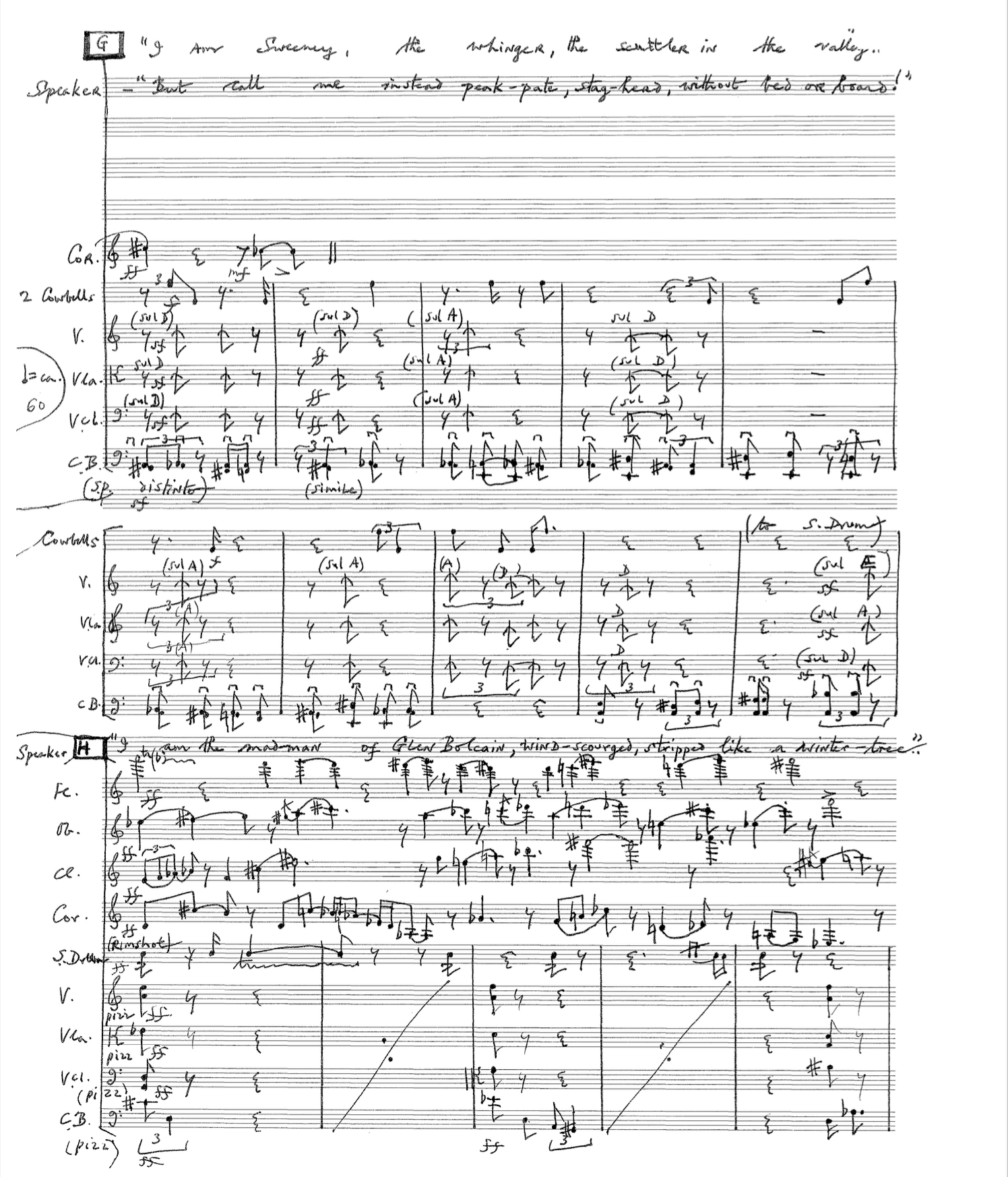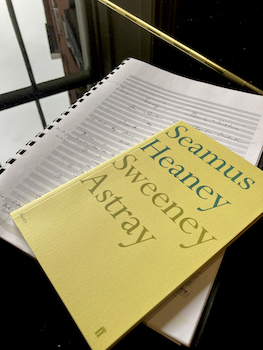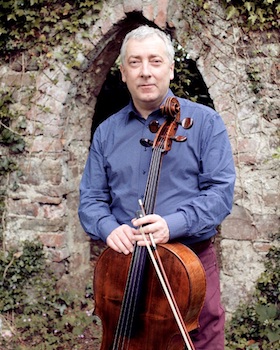Through the Digital Door: Seamus Heaney's 'Sweeney Astray'
This edition of Through the Digital Door is the first in a two-part series marking the 10th anniversary of Seamus Heaney’s passing on 30 August. To celebrate the legacy of one of Ireland’s best-loved poets we are focusing on two musical works by CMC composers Frank Corcoran and Neil Martin that were inspired by Heaney’s Sweeney Astray, a translation of the medieval Irish tale Buile Suibhne or Mad Sweeney.
Look out for part two on settings of Heaney's own poetry later in the month where we'll explore works by Seóirse Bodley, Éna Brennan, Deirdre Gribbin, and Ryan Molloy.
Mad King Sweeney
In the tale, the Pagan King Suibhne is enraged by the tolling of Saint Ronan’s bell and wants to banish him — and his Christian teachings — from the kingdom. In his fury, King Suibhne almost turns to violence, but is called away to the Battle of Mag Rath at the last moment. Grateful for the reprieve, the saint thanks God for protecting him and curses King Suibhne, condemning him to wander through the world naked.
Later, as Saint Ronan tries to reconcile the opposing armies during the battle, King Suibhne fires two spears at him and narrowly misses, striking the saint’s bell instead. In response, Saint Ronan curses the king once more, wishing him to fly through the air like a spear. Rejoining the battle after their exchange, King Suibhne finds himself fleeing from the conflict like a wild bird, finally coming to rest on a yew tree. With the king gone, his army crumbles and his opponents rise victorious. Under the influence of Saint Ronan’s curse, Suibhne flies around Ireland, driven mad by his restlessness.
Seamus Heaney: Sweeney Astray (1983)
Seamus Heaney began working on Sweeney Astray in 1972, not long after he and his family moved from Belfast to Glanmore in Co. Wicklow. In the introduction to the volume, Heaney notes that Sweeney's 'kingdom lay in what is now south County Antrim and north County Down, and for over thirty years I had lived on the verges of that territory, in sight of some of Sweeney's places and in earshot of others'. When he moved to Wicklow, Heaney found that he was not far from Sweeney's final resting place at St Mullins, which provided a further source of inspiration. After completing his first draft, Heaney set the work aside for 6 years before returning to it in 1979 during his first semester as a visiting professor at Harvard. The revised version was published in Derry by Field Day in 1983.
Frank Corcoran: Buile Suibhne (1996)
Frank Corcoran was born in Tipperary and studied in Dublin, Maynooth, Rome and Berlin. He is a founding member of Aosdána, Ireland’s Academy of Artists, which honours those whose work has made an outstanding contribution to the creative arts in Ireland. His extensive output includes chamber, symphonic, choral and electro-acoustic music, through which he explores particularly Irish issues like language and history.
Corcoran’s Buile Suibhne for chamber ensemble and speaker sets text from Heaney's Sweeney Astray. The piece was composed in response to a commission from Slí Nua and it received its world premiere in January 1998 in Hamburg, Germany. On this occasion, Corcoran assumed the role of the speaker and was joined by the NDR Ensemble and conductor Dieter Cichewiecz.
In his programme notes for the piece, Corcoran writes:
My music pierces this spoken text, plays through it, lacerates, aerates, destroys, reinforces, mocks and celebrates the beauty of Sweeney’s words. The plangent oboe, hunting horn, flute as symbol of man’s flying soul, cloying and crying clarinet are all used virtuosically. A huge battery of percussion punctuates these sounds.
Listen to this extract from early in the work, which exemplifies Corcoran’s ability to evoke Sweeney's distress as he wanders cold and alone. Initially, the speaker's voice cuts across the restless music, but later in the extract Corcoran pares back the orchestration, removing the woodwind and using the strings to mimic the percussive imagery of the words. 'At Moira my tribe was beaten / beetled, heckled, hammered down…'
You can follow the start of the extract on the score below:

Taking further inspiration from the tale, Corcoran also created two electro-acoustic compositions around this time: Sweeney’s Vision (1997) and Sweeney’s Farewell (1998). He later wrote the chamber work Sweeney’s Smithereens (2000) and a piano piece entitled Sweeney’s Total Rondo (2001). This last composition features in CMC’s publication Piano Album IV, a collection of test pieces commissioned by RTÉ Lyric FM for the 2003 AXA Dublin International Piano Competition. Corcoran spoke to CMC's Jonathan Grimes about his interest in Mad Sweeney in 2004; you can read the full interview here.
Neil Martin: Sweeney (2018)
Neil Martin is a composer and musician from Belfast whose work has been performed across the world and even on the International Space Station! His commissions include music for orchestra, choir, TV, film, and radio. As a cellist and an uilleann piper he has worked with many leading musicians – both on stage and in the studio – as well as the LSO, RPO, and all the principle orchestras in Ireland.
Martin’s orchestral song cycle Sweeney was composed in 2017-18 and received its first performance at the National Concert Hall, Dublin on St Patrick’s Day in 2018. The singer Iarla Ó Lionáird, who had suggested that Martin set Heaney’s text to music, performed at the premiere alongside actor Stephen Rea and the RTÉ Concert Orchestra, conducted by David Brophy.
In his programme notes for Sweeney, Martin remarks:
Generally, singing a sentence takes longer than saying one, so I felt from the outset that in order to tell a version of this epic that retained its flavour and arc, the role of narrator would be essential. Fairly immediately, working now primarily off Heaney’s text, the division of the story-telling between singer and narrator became clear – the singer would sing the quatrain verses of Sweeney and the narrator would narrate the prose, Greek chorus-like.
Martin and Heaney were friends for over twenty-five years and Martin dedicated Sweeney to Seamus's family. He also composed other settings of Heaney’s translations, including a rendering of the chorus from The Cure at Troy for choir and orchestra and a version of the Aeneid Book VI for voice and cello.
You can listen back to the first radio broadcast of Sweeney on RTÉ’s Lyric Live. The broadcast begins with an interview with Neil Martin.
The work opens with the narrator who begins unfolding the narrative and introducing the story's protagonists in line with Heaney's Sweeney Astray. The singer enters shortly after, delivering Saint Ronan’s thanks to God. This interplay between the narrator, singer, and orchestra continues throughout the work. Martin’s score is richly atmospheric, managing to evoke the rural setting and the roving nature of Sweeney’s flight.
Performances of Sweeney are taking place on 15 August in Dublin and 16 August in Kilkenny to mark the tenth anniversary of Seamus Heaney's passing. Tickets are available from the National Concert Hall and Kilkenny Arts Festival.



